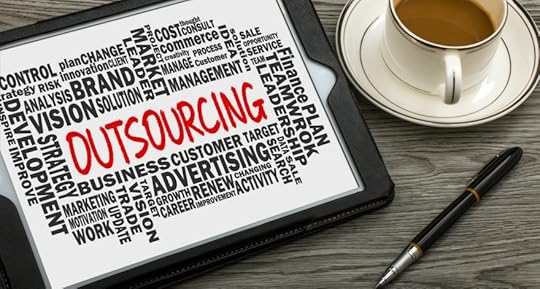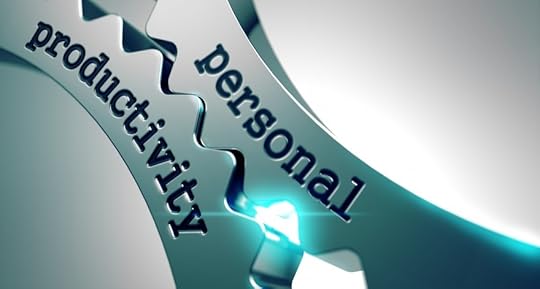Mike Vardy's Blog, page 87
May 25, 2015
The Climb: Why I’m Going Beyond Productivity

Back when Miley Cyrus was Hannah Montana, my daughter was a fan. She eventually outgrew it, but before she did she asked if we could go see Hannah Montana: The Movie. So we did.
It was pretty unmemorable fare, but there was one thing about the film that has stuck with me. The song at the end of the film called “The Climb.”
I don’t mind the song all that much, mainly because of the lyrics. While I’m not sure what the song is exactly about, it struck a chord with me because I’ve done a lot of climbing in my work.
“There’s always gonna be another mountain; I’m always gonna wanna make it move. Always gonna be an uphill battle; Sometimes I’m gonna have to lose. Ain’t about how fast I get there. Ain’t about what’s waitin’ on the other side. It’s the climb.”
I started out as a productivity parodist. That led me to writing for several websites and then editing for others. Eventually, I became known for my work in productivity and went from being a productivity enthusiast to a productivity specialist. Now I am on my way to becoming a productivity strategist.
I have climbed a lot. I’m sure you have too. I’m about to climb even higher… and that’s a very scary thing for me right now.
Deep down I know I’ll get used to the height I’ll be at, and I’ll be fine once I’m there. But I also can’t help but think how much further I have to fall. I know that it’s risky for me to climb further, but the reward is that much greater by doing it. The climb is exciting because it will lead me to new territory . But it’s also scary because it will be unknown territory.
Every time I climb higher I go beyond where I was before. This time, however, I’m not just going beyond where I’ve been. I’m going beyond productivity.
I’m taking things to a new place. I’m not only leveling up my work and life, but I’m putting something out there that will level up the work and lives of others in a way that I’ve done before. Sure, I’ve done it through Productivityist Coaching and in smaller workshops, but never on the scale that I’ve put in place this time.
All of that has me scared. And that’s a good thing.
It means I’m going to raise my game. It means I’m going to be on the ball so that I don’t fall. It means that I’m going to deliver the goods.
Whether you’re taking things to the next level at the office through a new initiative you’re in charge of, taking things to the next level by embarking on a new career path, or taking things to the next level by adding to your family or building a relationship with someone new, you’re going to be scared. You’re going to have doubts. You’re going to want to turn back – even if only for a second.
But when you feel all of that just remember: It’s not about what’s on the other side. It’s the climb.
I’m going to talk about ways you can make the climb a little less scary during my Beyond Productivity workshop. I’ll be offering some proven strategies that will create less friction for you along the way and reveal how my productivity approach (The NOW Year Formula) can help you climb where you want- and as high you want – so that you can have more of what you want in life. Whether you’re able to join me in person during the live broadcast or if you want to have access to the workshop to view at your leisure, you can get access to Beyond Productivity by purchasing your ticket here.
The post The Climb: Why I’m Going Beyond Productivity appeared first on Productivityist.









May 21, 2015
Outsourcing Services to Virtual Staff: Is It Worth It?

I’m preparing for my live streaming event Beyond Productivity, so I’ve enlisted the help of additional contributors this week. The following is a guest post from Felix Tarcomnicu. Felix is an entrepreneur that helps small business owners outsource work to virtual assistants. You can connect with him on Twitter.
Outsourcing was designed primarily as a cost management strategy. Companies that outsource average 40% reduction in the cost of operations which translate to higher savings or increased investments in core functions. Outsourcing works by capitalizing on comparative cost advantages and economies of scale that are available in the region. Since the advent of the new millennium, the idea of outsourcing has evolved from a purely cost-management strategy to a strategic partnership because of its ability to institute improvements in revenue generation.
Any business, regardless of size or scale, will benefit from outsourcing services. This is especially true if you own a small business with tight budgets and limited access to capital. As a small business owner, you have to manage your costs in order to keep operations funded. Having tight funds will make it difficult to implement expansion programs. The focus of small business should not just be on cost reduction but on increasing savings as well. The best solution for small business owners is to outsource services to a virtual staff.
Here are five benefits of outsourcing services:
1. Lower your costs. Virtual staff is comprised of people who work online usually from a remote location and are contracted to provide services or manage a specified project. Virtual employees are paid on average $7 to $10 per hour depending on skill and experience. Those who are from remote locations such as the Philippines and India will cost lower at $4 to $7 per hour. Virtual employees are essentially freelancers; they can work for anyone and are not exclusive to your campaign even after you’ve hired them. Thus, they are not entitled to benefits. By comparison, a regular office employee will cost on average $20 per hour and are entitled to government and company mandated benefits. The estimated cost of a regular employee including benefits is equivalent to one-and-a-half times the basic salary.
2. Increase productivity. Hiring a virtual staff will increase your productivity because they are paid based on productive hours worked. Productivity can be measured on the tasks accomplished or on benchmarks established by the client. Regular office employees get paid for the entire eight-hour shift whether it has resulted in productivity or not. According to a study by Personal Development Coach Steve Pavlina, the average office worker only generates 90 minutes of productive time per day. The rest of his work hours are spent unproductively such as Internet surfing, chatting with co-workers, social media and taking coffee breaks.
3. Improve flexibility. If the members of your virtual staff are all from remote locations, this gives you an opportunity to have your business managed more than 8 hours per day. For example, a client from Canada who contracts a virtual assistant from the Philippines can designate a morning work shift Manila time. This way, the Filipino virtual assistant can handle all calls, messages and inquiries that come to the attention of the client after office hours in Canada. By having the after office hours covered, you can be assured your business will not be at risk of missing opportunities and inquiries can be attended to right away.
4. Buys you time. For business owners, time-management is a must. You should be able to attend to essential tasks or those that are directly related to the conduct of your business. But at the same time, you need to address administrative matters as well. Although defined as non-essential, administrative tasks lend organization to the business and must be regularly updated. Administrative tasks include e-mail filtering, phone handling, CRM work and calendar management among others. A virtual staff can have this covered and done expertly. In the meantime, you would have the availability to work on matters that deserve your attention and require your core competence.
5. Better quality of work. The virtual assistant has come a long way since being hired primarily for secretarial or personal assistant services. Nowadays, the scope of virtual assistance work covers a wider range of skill and required higher levels of competence.
An ideal virtual staff for a small business owner should cover the following functions:
Accounting Administrative work Website management Social media managementIncorporating this set up ensures your business has adequate support services and a team that markets and promotes your services.
Outsourcing services to a virtual staff will result in greater profitability for your business because of both increased cost management and revenue generation; the variables in the profitability equation are effectively addressed.
The post Outsourcing Services to Virtual Staff: Is It Worth It? appeared first on Productivityist.









May 18, 2015
Celebrate Tonight To Boost Your Productivity Tomorrow

I’m preparing for my live streaming event Beyond Productivity, so I’ve enlisted the help of additional contributors this week. The following is a guest post from my friend Karl Staib. Karl helps smart leaders reduce turnover, improve productivity, and multiply creativity, so you and your employees get more done while feeling happy throughout the process. Get the first 6 modules of the Work Happy Now Emergency Kit – Break in case of stress overload for free when you sign up for updates.
An unfortunate incident occurred during my stay at the Portland Marriott last summer.
I went to bed and I forgot to do one of my most important rituals. I didn’t do my 2 minute meditation and review of my day.
I took off my clothes, brushed my teeth, plopped into bed, and fell asleep.
Yes, it was 1 a.m., but I woke up mad at myself.
Of course, after I woke up, I tried to shake it off this upset feeling, but I couldn’t. As I sat there listening to the speaker up on stage, I realized why. Those 2 minutes of meditation, and 2 minutes of noting my day give me time to process my emotions.
Emotions are very important to being productive.
Before I explain why, let me step back a few hours.
I was at dinner with some friends. I struck up a conversation with a woman next to me. We chatted about the food. I had a lamb burger that was amazing. She had a Salmon salad that actually made me jealous of my lamb burger. We chatted about our kids and we talked about our businesses.
It was a nice conversation. By the end of the night she walked up to me and said, we need someone like you to help us. My team is great, but we could be better. I try to make them happy, but you are right. I don’t create positive experiences that helps them grow as a team. She handed me her card and I had a really good feeling she would become a client.
I smiled and walked back to my hotel. This is when I brushed my teeth and forgot to do my end of the night ritual. I didn’t celebrate the great conversation and the opportunity to land a new client. I just went back to my hotel and went to sleep.
Shame on me!
I didn’t take the advice I give to so many of my clients.
Celebrate your hard work.
When you look back on all the circumstances it took you to get into a certain position it’s amazing. All the hard work. All the time it took for me to be confident in how I communicated. EVERYTHING!
For me to just brush it off wasn’t fair to me.
So I left the conference went to a coffee shop. I took my time to do a little Zen meditation with my coffee, slowly sipping it while I thought about last night. Then I jotted down everything that went well yesterday. I felt so much better.
Then I went back to the conference with a hop in my step.
Gratitude is so important as it helps you stay positive when you are having a rough week. It helps you stay productive even when you feel like crawling under our desks and taking a nap.
So how can you bring more gratitude to your days on a regular basis?
As you probably can guess, I’m going to encourage you to celebrate more. Now the thing is you respond to celebration differently than me, your best friend, and Paul McCartney.
You need to make a celebration plan that brings YOU the most happiness.
Now this is the hard part that most people avoid, but you won’t any longer. I am going to lay it all out for you. Here is my entire process and I suggest you alter it to fit your own personality.
1. Create a Review Ritual that FitsUse any method that fits your personality. You can use write in a journal, record your voice, video, talk with a generous friend who is willing to listen to your review, etc. When you create a ritual that is fun for you and doesn’t feel like you are receiving a dozen paper cuts on your big toe.
2. Use Action TriggersThe most important part of this is your when and the how (your action triggers). Stick with it for a week before you decide to improve it. I find that I like to review my day after dinner and before I shut down for the night. I meditate for 2 – 15 minutes then I write down the good things that happened during the day. If it’s a big win for me I will make the celebration bigger like going out to dinner, but for the most part just reviewing the positive aspects of my day is celebration enough for me.
Some of you might like to celebrate with a glass of wine or with a piece of chocolate or reading a comic. Do whatever it is that helps you appreciate your hard work. When you implement this habit you will reap the benefits of celebration.
The core idea here is to use celebration as a way to build better and more productive habits.
3. Improve It Over TimeI started out this process by keeping a gratitude journal at the end of each workday for over a year. Then I added components to help me process my struggles, what I could improve on for tomorrow, and any stories that I would like to share with my audience.
As you look over these three steps you are probably thinking about how you can implement it. Good!
Now It’s Your TurnTake five minutes to write down a quick plan to bring more celebration to your productivity. Give it a try for a week and see what aspects you like and what could be improved. Remember this process shouldn’t be tedious, it should bring you joy and encourage you to improve by just 1% a day.
Now, it’s your turn to look at what you can do to make celebration a bigger part of your schedule. What should you have celebrated yesterday? Take a moment to celebrate this hard work right now. Take a walk, pour yourself a delicious cup of cold water and take a moment to remember how hard you worked. Whatever it takes to help you soak in these good feelings.
The post Celebrate Tonight To Boost Your Productivity Tomorrow appeared first on Productivityist.









May 15, 2015
Why I Journal (And Why You Should Too)

I journal so that I can celebrate the day gone by…and to plan for the day to come. Without writing out my successes and failures of the day, I’d have less direction to go forward.
I journal to review and reflect every day so that when I attempt a deeper reflection and review I’m better prepared to do so. I no longer have to review every week as a result. I can do a deeper review semi-monthly and the daily habit of journaling allows me to still keep connected with all that I have going on in my life.
I journal to connect better with all aspects of me – both my work and my life. I journal because that connection gives me purpose and drive.
I journal to remain grounded. It keeps me honest. It’s that honesty that keeps me authentic and allows me to do what I do better each day.
I journal to get it all out. I clear my mind which gives it the freedom it needs to do things better. After all, the mind is meant to be a factory, not a warehouse.
I journal to figure what out what I need to do and what I ought to do. That also helps me drill deep into what I ultimately want to do and helps me achieve it.
I journal for all of these reasons…and more. But mainly I journal to chronicle my path towards a better version of me. Because I’m worth it.
Aren’t you?
The post Why I Journal (And Why You Should Too) appeared first on Productivityist.








 CommentsGreat article Mike. I've been trying to get into the habit of ... by Harris
CommentsGreat article Mike. I've been trying to get into the habit of ... by Harris
May 11, 2015
Why You Need To Take Personal Productivity Personally

Over the past few weeks, I’ve published a series for newsletter subscribers that discusses why I am no longer using Getting Things Done as my personal productivity approach. If you’d like to give all three parts a read, here are the links to those newsletters in the archives:
So Long, GTD: The First Reason Why I’ve Left Getting Things Done Behind So Long, GTD: The Second Reason Why I’ve Left Getting Things Done Behind The Third Reason I Stopped Using GTD (And A Glimpse At What I’m Using Now)The feedback I received on the series was mostly positive. There were a lot of people — and are a lot of people — who have either tried and never really adopted the methodology or used it for years and eventually abandoned it. However, there were some emails I received that questioned whether or not I was “doing GTD right” and comments from those who unsubscribed who were disappointed that I was leaving the methodology behind and possibly positioning the series as a way to promote and sell the new approach I’ve developed.
I was doing GTD right. I’m still a big fan of what GTD can offer people. But the thing about productivity approaches is that they need to be “personal” in order to be as effective as possible. I strongly believe that we need to start using the term “personal productivity” more often because it’s such a subjective area in so many ways.
Everyone has their own way of doing things and some will be more effective than others. But to suggest that using one approach over another is the best course of action for everyone is shortsighted. Some people are not going to be able to grasp the elements of one system over another as easily. Some people are going to be more visual than others. Some people are going to be more digitally inclined with their approach than others. Productivity is so personal at its core that when you are forced to use a system you aren’t comfortable with you can feel less connected to the tasks on your to do list and, as a result, have more difficulty accomplishing them in an effective and efficient manner.
Let’s look at email management as an example. Some people are simply going to use their email application to manage their tasks rather than any sort of dedicated task management application. Why would they do this? Perhaps it’s easier. Perhaps it’s mandated by their company (I know of some organizations that enforce this type of task management process). You can use the GTD methodology if you are using your email application to manage your stuff. You can use any methodology if you want – even one that you’ve developed yourself. The thing is is that you need to use something.
Your approach is likely to be different then the person sitting in the next cubicle. My approach to productivity is very different than my wife’s approach. Whether you use GTD, Agile, Kanban, the Franklin/Covey Method, Leo Babauta’s Zen To Done, or some other approach to personal productivity — the key is to make sure that the approach allows you to treat everything that you need to do and want to do as personally as possible. By that I mean to treat your tasks with the highest level of attention and intention.
You owe yourself that.
GTD has been around for nearly 15 years. David Allen has recently updated the book that started it all and during our discussion on The Productivityist Podcast he said that he basically rewrote the thing. Why? I’ve read it and I would say that the methodology itself has evolved, albeit not considerably. So, too, has the creator of the methodology. GTD has a ton of followers and supporters because it is help them better connect with all of the things that they have on their various lists. But it hasn’t worked for everybody – regardless of who they are, how long they’ve used to the system, and what they do.
And that’s okay.
When I wrote the series for my newsletter, I was using it as a vehicle to introduce the approach I’m using now. But there’s more to it than that. I’ve been a follower of GTD for so long that I felt I needed to provide some backstory and reasoning as to why it no longer worked for me. I’ve written about GTD so many times that I didn’t want to just stop discussing it altogether. I wanted to let my newsletter audience in on it before I put it out to the world in a much more open way. I believe the series accomplished that.
Some people have asked whether or not I will continue to talk about GTD here and elsewhere. The answer to that is simple: absolutely. GTD is a phenomenally mature systematic approach that has helped (and continues to help) a ton of people get things done. It would be shortsighted not to discuss the merits of the approach.
But I will also shine a spotlight on my own approach going forward because it’s also working for people – myself included. And frankly, it would be shortsighted not to discuss the merits of my approach.
Here’s the thing: no matter what approach you use, do everything you can to make it as personal as possible. The best way to get more of the right things done is to connect with the tasks on your list as personally as possible. A trusted system helps you do that because it helps you realize your potential, gives you leverage, fosters awareness, and nurtures your long-term needs and wants. And that means you need to make it your system, whether it’s GTD, The Now Year Formula, or something you’ve built from other various personal productivity approaches.
The post Why You Need To Take Personal Productivity Personally appeared first on Productivityist.








 CommentsThanks, Harris! It can wind up being the tail wagging the dog ... by Mike VardyGreat article Mike! I actually just wrote a similar article ... by Harris
CommentsThanks, Harris! It can wind up being the tail wagging the dog ... by Mike VardyGreat article Mike! I actually just wrote a similar article ... by Harris
May 7, 2015
Book Review: Get Smarter
It might not seem like it considering the number of book reviews I do, but sometimes I get in a reading rut. Days will go by when I haven’t read a book and despite my best attempts to try tactics that have worked in the past I can’t seem to start a new book. Then I pick up something like Get Smarter: Life and Business Lessons by Seymour Schulich and suddenly I’m off again.
by Seymour Schulich and suddenly I’m off again.
Get Smarter is like a series of notes from Schulich about how to conduct both your professional and personal lives. If a wise CEO were to use Tumblr, this would be its print form. The book is full of great anecdotes, quotes from others, and real business lessons. It also includes suggestions to improve your health and relationships, but this portion of the book did not resonate with me as much.
 This book reminded me that no one gets everything right. I no longer need to look with guilt at the domains I no longer update, or the great business ideas that didn’t work out. Or at the sushi mat in my kitchen cupboard representing failed attempts at making sushi at home. Many of these lessons are ones I’ve only learned after making mistakes. This is where Schulich’s book shines; we get to pickpocket Schulich’s life to find the hundred dollar ideas. In reading, we get the benefit of life lessons without the lesson costs.
This book reminded me that no one gets everything right. I no longer need to look with guilt at the domains I no longer update, or the great business ideas that didn’t work out. Or at the sushi mat in my kitchen cupboard representing failed attempts at making sushi at home. Many of these lessons are ones I’ve only learned after making mistakes. This is where Schulich’s book shines; we get to pickpocket Schulich’s life to find the hundred dollar ideas. In reading, we get the benefit of life lessons without the lesson costs.
Three of my favorite:
“Know your edge.” Schulich used to ask people, “How do you defeat chess prodigy Bobby Fisher?” When people stared blankly back at him, he answered, “play him in anything but chess.” Knowing what you are good at or what you can be good at will give you an advantage.
This was the case with Samuel Zemurray, America’s ‘Banana King’ who used to say, “they’re there, we’re here.” Zemurray knew that his edge was being physically located on the banana plantations, on the transport ships, and at the wharfs while they were unloaded. This let him see what was going on, rather than managing the company – as his contemporaries did – from Boston.
“Be the promoter, not the promotee.”
Schulich writes, “every profession is a conspiracy against lay people.” Conspiracy seems like a harsh word, but it serves to make his point – that professionals know a lot more about their business than anyone else. This means that those who aren’t, need to find a way to catch up to speed.
Radio host Dave Ramsey suggests people find a financial advisor “with the heart of a teacher” as a means to not be taken advantage of. Ramit Sethi suggests that people become real estate experts before they buy their first home. When they ask “Really?” Ramit says, “yeah, for the biggest purchase of your life I think you should.” If you read other blogs like this one you need to ask, what does the person writing know that I don’t and does that matter?
On Partnerships.
“The key to successful partnerships is mutual veto power. If you cannot agree on a major proposition, don’t do it.” This seems like a handy rule to have in any relationship. Schulich writes about a number of partnerships in the book and always notes that they bring different ideas to the table. Sometimes he doesn’t think these different ideas are correct, but just the act of reasoning to himself why they aren’t is valuable.
In some ways, this is what Samuel Zemurray did, who never took on a partner. Early in his life, when he was sleeping on freight trains with his bananas, a partnership likely wouldn’t have worked. Later in life though, a partnership would have helped him see that staging governmental coups and packing bananas in boxes to prevent bruising could have extended the life of his company.
Get Smarter is a good book, but not a great one. You likely won’t walk away inspired or have a completely new way of solving a problem, but you don’t have to. If you take a few things away from this book that makes you a better person, this is a productive use of your time. If you’ve read it, let me know. If you have any other suggestions for books, let’s chat about that too.
The post Book Review: Get Smarter appeared first on Productivityist.









May 4, 2015
Why Being “In Between” is The Black Hole of Productivity

Great work requires both time and space, but you also need both attention and intention to deliver quality results.
But attention without intention is powerless. Why? Because unless you know why you’re dedicating energy, focus, and time to something it won’t get your full effort. The reason behind giving something the attention deserved can be decided either by need or by want. But once you have any sort of dilution of intention in there, then the power of attention is diminished.
Conversely, intention without attention is directionless. It’s like saying that you want to score a goal but you don’t bother to look at the net when you shoot. The goal is rarely realized when this happens, and certainly won’t happen consistently if you fail to look every single time. When WWE personality Triple H appeared on The Tim Ferriss Show he offered up the following quote:
“…a dream is something you fantasize about…a goal is something that you set a plan (for), work towards, and achieve.”
Dreams need to become goals to seem real. These goals need to become projects to be realized in some way, shape, or form. In order to seem real, dreams must be divided into goals. Then the goals are broken down into projects. In order for this transition to happen, you need to give attention to each intention. If you don’t, you sell your dreams, goals and yourself short.
One of the best ways to level up both your intentions and your attention is to say “no” more often. You can say “no” to external offerings and do the same for internal offerings that deliver more conflict than results. External offerings can be things like writing that guest post for a site that you don’t really have time to focus on or teaching someone how to do make their computer work better. Internal offerings are things like trying to figure out if you should do guest posts for sites or whether or not helping friends and family with their computers is a good use of your time, energy, and expertise.
Ultimately you want your intention and attention to be focused on the things you need to do and want to do – and not what you think you ought to do. Those things you think you ought to do are the things you’re not sure about – should you do them, have someone else do them, or drop them altogether? The “ought to do stuff” is where you get stuck. They are the ones that rest somewhere in between. They are the ones that keep us from putting as much into what we need to do as we can and they also prevent us from spending enough time on the things we really want to do.
You need to decide whether these tasks – the “ought to do” tasks that leave you settled in the in between – are worth doing or not worth doing, otherwise you’ll wind up in a productivity black hole that can suck you in and overwhelm you.
I’ll be writing more about intention, attention, and how to avoid the pitfalls of those “ought to do” tasks more in the future because I want you to have a simple, flexible, and durable way to do that. Because that’s what we all need…and what we all want.
The post Why Being “In Between” is The Black Hole of Productivity appeared first on Productivityist.









April 30, 2015
How To End This Month (And Start The Next Month) Right

There are certain aspects of the calendar that I really appreciate, and the end of the month is one of them. Even more so than the end of the calendar year (which – as I’ve written about – doesn’t hold as much significance for me), the end of the month is a time where I can get set for the next 30 or so days while looking back at the 30 days prior.
I start and end my days the same way and over the past few months, I’ve done the same with a calendar month. By doing so, I’ve found that I get a solid reset and recharge every 30 days – something that has definitely boosted my overall productivity. I’ve been able to scale my plans up, map my days better, and align myself with my monthly and daily themes a lot better since starting to end my months in a similar fashion. Essentially, by ending my current month right I start my next month off right as well.
Here’s how I do it.
1. Connect with the pastI don’t do a weekly review and haven’t for some time. Instead, I conduct semi-monthly reviews. I set aside an hour on the 15th and 30th of every month (except for February, which gets the semi-monthly review treatment on the 15th and 28th) and take a look at what the previous two weeks or so have presented to me. Because I keep a daily journal, this process is far less involved than what I used to do (The GTD Weekly Review) and reading what I wrote upwards of two weeks’ prior allows me to reconnect with what I’ve done and what I had set out to do.
2. CalibrateLooking back at my journal entries really allows me to align everything again as the month comes to a close. I can calibrate myself so that I have the ability to move forward with fewer questions and more resolve. This part of the process involves deliberate postponement of certain actions (which is easy to do in Todoist if you run the pointer/cursor over the small calendar that comes up when you are in the date field of a task), reviewing the various modes I use to tackle my work so that I can see what ones are working, what ones need to be improved upon through clarification (or outright dropping them), and aligning all of my actions with my daily themes as much as possible.
3. Choose the courseAt this point, I’m looking ahead to the Monthly Theme for next month and further defining what path I want to take to give that theme the attention it deserves. Choosing the course involves being very intentional. I am plotting a course of action and using my daily themes and mode-based working process to make measured progress on what I really want to make happen in the month ahead. I eliminate a lot of things to do this, which is now easier to do because I’ve spent the time looking back and then course correcting in the steps before choosing the way forward. My wheels are seasoned from the past miles they’ve traveled, better aligned thanks to the calibration they’ve undergone, and are now greased and primed for the road ahead.
If you fail to review regularly, then I encourage you to try this kind of end of month process to help you move forward with more precision, focus, and resolve in the months ahead. Taking just one hour to connect with the past, calibrate accordingly, and choose your course on the 30th of every month can help you go a long way.
The post How To End This Month (And Start The Next Month) Right appeared first on Productivityist.









April 27, 2015
Guitars, Growth, and Self-Assessment
This past weekend I decided to purchase a guitar. I’ve been thinking about it picking up the instrument for a while. What finally convinced me was hearing an interview with Grammy Award winner Steve Martin talk about learning to play the banjo. You could just hear the passion and excitement in his voice when he talked about playing music. I was convinced. I bought a guitar the next day.
Years ago, I tried to learn how to play the guitar when I was younger. There was a hand-me-down acoustic that moved through our family like a flu bug at the holidays, and it was about as comfortable. Knowing now, what I didn’t know then, I realized that guitar was pretty cheap and very hard to play. The strings weren’t in tune and the neck was warped after its many “tour stops” throughout Ohio, Pennsylvania, and North Carolina. After learning the introductory riff to Smoke on The Water, I realized that playing the guitar just wasn’t for me, in the same way a college student declines a political party or a child refuses brussels sprouts.
Many years later in graduate school, I wrote my master’s thesis on the connection between expectations of parents and student outcomes. There are two different mindsets which parents can pass on to their children. The first is a growth mindset where an individual thinks they can learn something new with the right mix of practice, instruction, and tools. The other is a fixed mindset where an individual thinks their abilities are relatively fixed, you are what you are. In the research I was looking at, there was a strong correlation between a mother’s beliefs about innate mathematics understanding and a student’s grade. For example, some mothers would rationalize with their students that “I wasn’t good at math either” as a means to explain a student’s poor performance.
As I wrote my thesis, I began to see that I was domain dependent with regards to my mindset in different areas of my life. My life was like a bowling alley, where lanes one and two were the sports I played, lane three were the books I read, and lane four was playing the guitar. I could happily go to lanes one, two, and three to practice and get better. Lane four felt odd and foreign. It felt different, even though it was nearly the same. Learning to play the guitar takes the same learning approach as other areas of life. Nassim Taleb writes about this in Antifragile :
:
“Some people can understand an idea in one domain, say, medicine, and fail to recognize it in another, say, socioeconomic life. Or they get it in the classroom, but not in the more complicated texture of the street. Humans somehow fail to recognize situations outside the contexts in which they usually learn about them.”
The question for productivity is this, In what areas are you domain dependent? Are you conquering inbox zero but letting papers pile up in your car? Are you building something great at work but neglecting the care your relationships need? Are you taking care of your work skills but not your physical health? What about the fixed versus growth mindsets? Ask yourself what areas you are dominating in and what areas you need to apply those same strategies of domination. Now if you’ll excuse me, I have to go practice my chord progressions.
The post Guitars, Growth, and Self-Assessment appeared first on Productivityist.









April 23, 2015
Completing Multiple Projects: An Interview with Adam McKay

Recently, Adam McKay was on Slate’s Working Podcast. This is an interview series where people share what it is they do all day. The guests range from school principals to bail bondsmen to McKay who writes, directs, and produces movies . If you aren’t familiar with McKay, he has written, produced, and directed blockbuster movies such as Anchorman, Anchorman 2 and Talledega Nights. One major reason for McKay’s success is that he’s worked really hard for a long time. When asked how he can do it all, he says, “I’ve just been doing this a long time. From the age of nineteen I was actively writing sketch. I took screenplay classes and I’ve watched thousands and thousands of movies.” says McKay.
. If you aren’t familiar with McKay, he has written, produced, and directed blockbuster movies such as Anchorman, Anchorman 2 and Talledega Nights. One major reason for McKay’s success is that he’s worked really hard for a long time. When asked how he can do it all, he says, “I’ve just been doing this a long time. From the age of nineteen I was actively writing sketch. I took screenplay classes and I’ve watched thousands and thousands of movies.” says McKay.
In this episode, there are also four productivity tips from McKay:
Define your day. McKay has three different roles in his career: writing, producing, and directing. Each one of these days requires a different mindset and attitude. On writing days, he knows that from 2:00-6:30 PM is his prime working time and not to schedule anything then. On directing days, he knows that lunch meetings take a lot of energy, so he needs to be fully present. On some days, the tasks include negotiating for book rights, and other times a day’s work involves pitching a project to someone. On directing days, he needs to be awake early to get the most of the daylight hours. Each day requires its own mental alignment. Plan your day. On writing days, McKay tries to spend “the first couple of hours identifying what I have to do.” McKay is involved with a slew of projects, from Funny or Die to uncredited script punch ups and says “if you don’t identify what you have to do, it feels overwhelming.” To add clarity to this perspective, the analogy given is how a runner knows the race course before running in the race. This time helps McKay arrange where he’s going and even plan out any breaks needed along the way. By using this approach, when it’s time to begin working McKay “gets a good gallop going.” Have stakes. Sometimes McKay will book a hotel room to write in. This, he says, helps him to get work done because it’s really embarrassing if you paid for a hotel room and didn’t do anything while you were there. He also says that writing in the afternoon feels the same way. If he doesn’t actually write then, he’s wasted an entire day. As Amy Poehler wrote , “the talking about the thing isn’t the thing, the doing of the thing is the thing.” You have to get the work done. When McKay leaves it for the end of the day, that means he knows it has to get done then or it won’t get done at all. Work with good people. McKay says that he and Will Ferrell started Funny or Die because they weren’t doing sketch anymore and missed the fun interactions. Not wanting to undertake a huge project, they quickly found they could work with funny people like Danny McBride, but not do all the work. It’s true for movies too, where McKay is on set for twelve hours a day, six days a week. A good project with good people can make a great experience. But the money, don’t ever do it for the money, “A few times in our company’s history we’ve done stuff because we thought it could be a great deal or could be great money there and every time we do that it doesn’t work out. We’ve had a couple crashing failures where we chased the deal rather than what we actually like and, fortunately, reality has been very clear to us about that so we stick to stuff we actually enjoy.”
, “the talking about the thing isn’t the thing, the doing of the thing is the thing.” You have to get the work done. When McKay leaves it for the end of the day, that means he knows it has to get done then or it won’t get done at all. Work with good people. McKay says that he and Will Ferrell started Funny or Die because they weren’t doing sketch anymore and missed the fun interactions. Not wanting to undertake a huge project, they quickly found they could work with funny people like Danny McBride, but not do all the work. It’s true for movies too, where McKay is on set for twelve hours a day, six days a week. A good project with good people can make a great experience. But the money, don’t ever do it for the money, “A few times in our company’s history we’ve done stuff because we thought it could be a great deal or could be great money there and every time we do that it doesn’t work out. We’ve had a couple crashing failures where we chased the deal rather than what we actually like and, fortunately, reality has been very clear to us about that so we stick to stuff we actually enjoy.” McKay added lots of other glimpses into his professional life about the value of his varied interests, what it’s like to work with Will Ferrell, and more. He also said, “once you get that first shot of the day, you got your momentum.”
How do you apply these? Do you apply any? Let me know in the comments.
The post Completing Multiple Projects: An Interview with Adam McKay appeared first on Productivityist.













